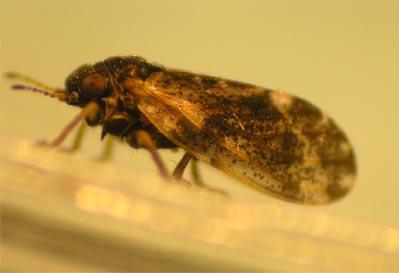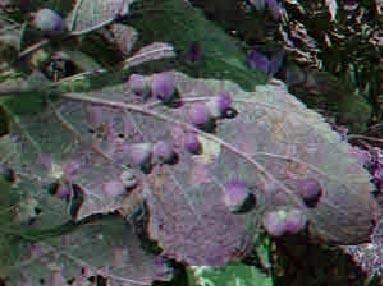Hackberry Psyllids and Other Jumping Plant Lice
ENTFACT-413: Hackberry Psyllids and Other Jumping Plant Lice | Download PDF
by Lee Townsend, Extension Entomologist
University of Kentucky College of Agriculture
Psyllids are aphid‑like insects that resemble miniature cicadas. Also called jumping plant lice, these tiny insects have hind legs that allow them to jump and fly away quickly if disturbed. Large swarms may be seen on sunny, warm autumn afternoons but the insects usually disappear after a killing frost. Psyllids are attracted to light colored surfaces and clothing, those that land on people can be a temporary nuisance. The tiny sap feeders may probe the skin, giving a small bite sensation but they do not feed on humans or pets.

Hackberry Psyllid

Hackberry Galls
Many psyllid species spend the winter in cracks and crevices of tree bark. They are attracted to lights and may enter through window screens or small cracks and crevices but generally do not survive for very long indoors and do not attack house plants, stored products, or furnishings.
Life Cycle
Hackberry psyllids develop on hackberry trees, causing distinct raised or swellings or galls on the leaves. Egg-laying occurs over a period of several weeks beginning when new leaves unfold from the bud. These psyllids stimulate abnormal growth of leaf cells causing formation of the gall in which the insects live and feed. The gall provides food and protection from many natural enemies. Infested hackberries do not seem to be harmed by the galls but severe infestations may cause early leaf drop. Other species have similar life cycles but develop on other host plants.
Management
Psyllids are usually held in check by natural enemies. Outbreaks can occur in some years resulting in temporary annoyance but aggressive control measures are not warranted nor are effective control measures available. Several applications of an insecticide would generally be necessary to keep an insecticide residue on the expanding leaves during the entire period that eggs are hatching. Spraying of large trees is difficult and without powerful sprayers, it is difficult to get the good coverage that is needed. If chronic problems occur, removal of the source plants may be worthwhile.
Revised: 11/12
CAUTION! Pesticide recommendations in this publication are registered for use in Kentucky, USA ONLY! The use of some products may not be legal in your state or country. Please check with your local county agent or regulatory official before using any pesticide mentioned in this publication.
Of course, ALWAYS READ AND FOLLOW LABEL DIRECTIONS FOR SAFE USE OF ANY PESTICIDE!
Images: University of Kentucky Entomology.
